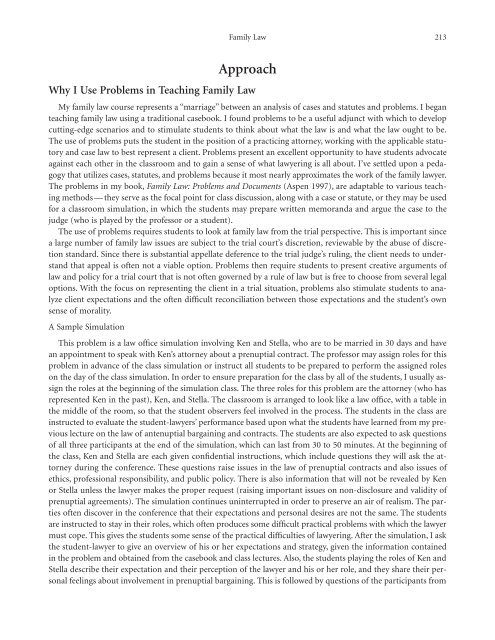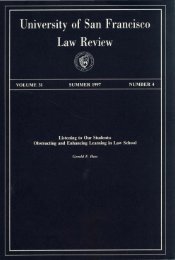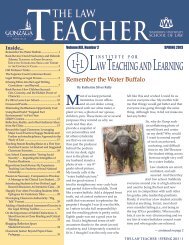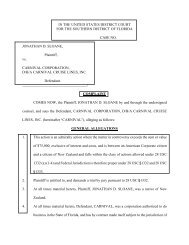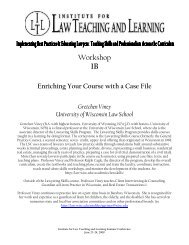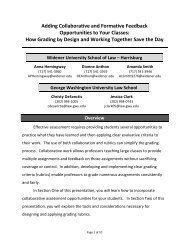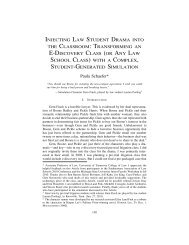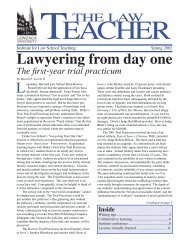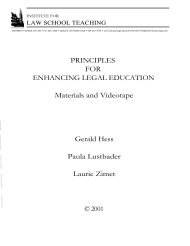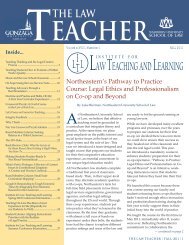Teaching the Law School Curriculum - Institute for Law Teaching ...
Teaching the Law School Curriculum - Institute for Law Teaching ...
Teaching the Law School Curriculum - Institute for Law Teaching ...
You also want an ePaper? Increase the reach of your titles
YUMPU automatically turns print PDFs into web optimized ePapers that Google loves.
Family <strong>Law</strong> 213<br />
Approach<br />
Why I Use Problems in <strong>Teaching</strong> Family <strong>Law</strong><br />
My family law course represents a “marriage” between an analysis of cases and statutes and problems. I began<br />
teaching family law using a traditional casebook. I found problems to be a useful adjunct with which to develop<br />
cutting-edge scenarios and to stimulate students to think about what <strong>the</strong> law is and what <strong>the</strong> law ought to be.<br />
The use of problems puts <strong>the</strong> student in <strong>the</strong> position of a practicing attorney, working with <strong>the</strong> applicable statutory<br />
and case law to best represent a client. Problems present an excellent opportunity to have students advocate<br />
against each o<strong>the</strong>r in <strong>the</strong> classroom and to gain a sense of what lawyering is all about. I’ve settled upon a pedagogy<br />
that utilizes cases, statutes, and problems because it most nearly approximates <strong>the</strong> work of <strong>the</strong> family lawyer.<br />
The problems in my book, Family <strong>Law</strong>: Problems and Documents (Aspen 1997), are adaptable to various teaching<br />
methods — <strong>the</strong>y serve as <strong>the</strong> focal point <strong>for</strong> class discussion, along with a case or statute, or <strong>the</strong>y may be used<br />
<strong>for</strong> a classroom simulation, in which <strong>the</strong> students may prepare written memoranda and argue <strong>the</strong> case to <strong>the</strong><br />
judge (who is played by <strong>the</strong> professor or a student).<br />
The use of problems requires students to look at family law from <strong>the</strong> trial perspective. This is important since<br />
a large number of family law issues are subject to <strong>the</strong> trial court’s discretion, reviewable by <strong>the</strong> abuse of discretion<br />
standard. Since <strong>the</strong>re is substantial appellate deference to <strong>the</strong> trial judge’s ruling, <strong>the</strong> client needs to understand<br />
that appeal is often not a viable option. Problems <strong>the</strong>n require students to present creative arguments of<br />
law and policy <strong>for</strong> a trial court that is not often governed by a rule of law but is free to choose from several legal<br />
options. With <strong>the</strong> focus on representing <strong>the</strong> client in a trial situation, problems also stimulate students to analyze<br />
client expectations and <strong>the</strong> often difficult reconciliation between those expectations and <strong>the</strong> student’s own<br />
sense of morality.<br />
A Sample Simulation<br />
This problem is a law office simulation involving Ken and Stella, who are to be married in 30 days and have<br />
an appointment to speak with Ken’s attorney about a prenuptial contract. The professor may assign roles <strong>for</strong> this<br />
problem in advance of <strong>the</strong> class simulation or instruct all students to be prepared to per<strong>for</strong>m <strong>the</strong> assigned roles<br />
on <strong>the</strong> day of <strong>the</strong> class simulation. In order to ensure preparation <strong>for</strong> <strong>the</strong> class by all of <strong>the</strong> students, I usually assign<br />
<strong>the</strong> roles at <strong>the</strong> beginning of <strong>the</strong> simulation class. The three roles <strong>for</strong> this problem are <strong>the</strong> attorney (who has<br />
represented Ken in <strong>the</strong> past), Ken, and Stella. The classroom is arranged to look like a law office, with a table in<br />
<strong>the</strong> middle of <strong>the</strong> room, so that <strong>the</strong> student observers feel involved in <strong>the</strong> process. The students in <strong>the</strong> class are<br />
instructed to evaluate <strong>the</strong> student-lawyers’ per<strong>for</strong>mance based upon what <strong>the</strong> students have learned from my previous<br />
lecture on <strong>the</strong> law of antenuptial bargaining and contracts. The students are also expected to ask questions<br />
of all three participants at <strong>the</strong> end of <strong>the</strong> simulation, which can last from 30 to 50 minutes. At <strong>the</strong> beginning of<br />
<strong>the</strong> class, Ken and Stella are each given confidential instructions, which include questions <strong>the</strong>y will ask <strong>the</strong> attorney<br />
during <strong>the</strong> conference. These questions raise issues in <strong>the</strong> law of prenuptial contracts and also issues of<br />
ethics, professional responsibility, and public policy. There is also in<strong>for</strong>mation that will not be revealed by Ken<br />
or Stella unless <strong>the</strong> lawyer makes <strong>the</strong> proper request (raising important issues on non-disclosure and validity of<br />
prenuptial agreements). The simulation continues uninterrupted in order to preserve an air of realism. The parties<br />
often discover in <strong>the</strong> conference that <strong>the</strong>ir expectations and personal desires are not <strong>the</strong> same. The students<br />
are instructed to stay in <strong>the</strong>ir roles, which often produces some difficult practical problems with which <strong>the</strong> lawyer<br />
must cope. This gives <strong>the</strong> students some sense of <strong>the</strong> practical difficulties of lawyering. After <strong>the</strong> simulation, I ask<br />
<strong>the</strong> student-lawyer to give an overview of his or her expectations and strategy, given <strong>the</strong> in<strong>for</strong>mation contained<br />
in <strong>the</strong> problem and obtained from <strong>the</strong> casebook and class lectures. Also, <strong>the</strong> students playing <strong>the</strong> roles of Ken and<br />
Stella describe <strong>the</strong>ir expectation and <strong>the</strong>ir perception of <strong>the</strong> lawyer and his or her role, and <strong>the</strong>y share <strong>the</strong>ir personal<br />
feelings about involvement in prenuptial bargaining. This is followed by questions of <strong>the</strong> participants from


